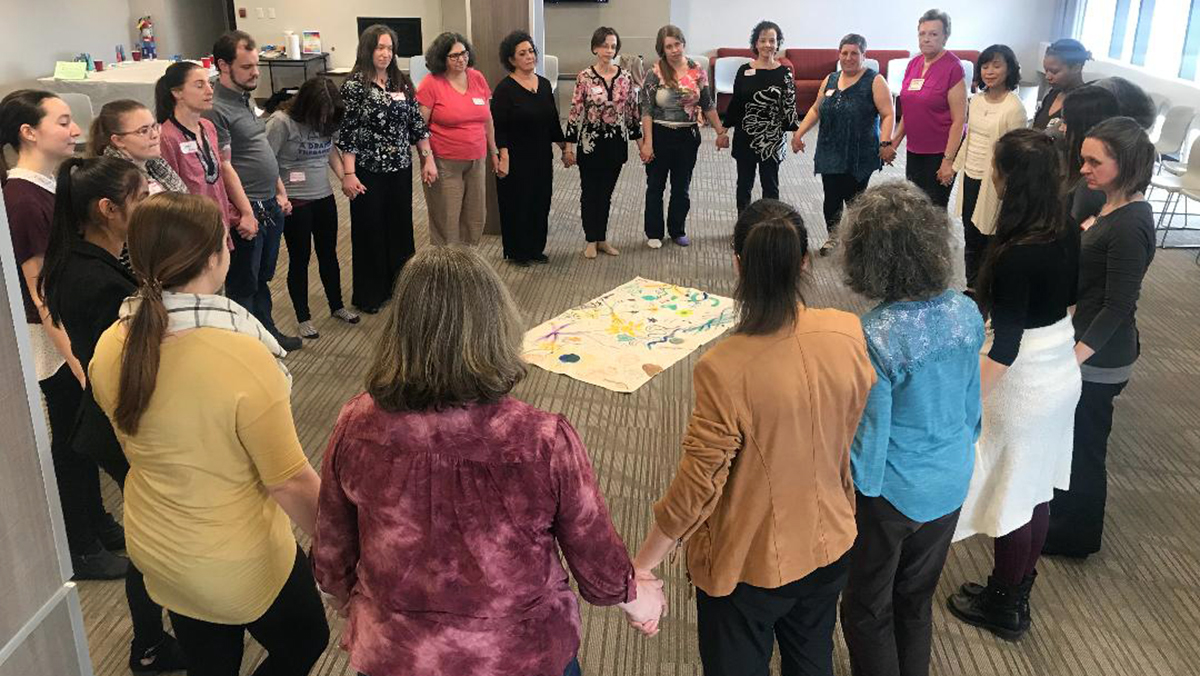Tuesday, Apr 23, 2019
by Keith Fernbach
On March 30, approximately 50 creative arts therapists gathered at Rider University for the first-ever Rhythm in Community conference.
The event, which was presented by the New Jersey chapter of the American Dance Therapy Association and the New Jersey Association for Music Therapy, brought together practitioners from the fields of dance/movement therapy, music therapy and drama therapy to share ideas, discuss best practices, engage in experiential exercises and talk about ways to increase awareness of the creative arts therapies in New Jersey.
Eri Millrod, a board-certified dance/movement therapist and an adjunct assistant professor in Rider’s Department of Theater and Dance, was instrumental in bringing this event to Rider. One of her goals in having Rider host the conference was to position the school as a leader in the field and promote the fact that starting this fall, Rider will become the first college in New Jersey to offer a master’s degree concentration in dance/movement therapy.
“I want to establish Rider University as a place where people can turn to exchange information and communicate with each other,” she says. “A lot of the time creative arts therapists end up working in isolation, so it’s very stimulating and inspiring for us to hear about how everybody is working in these little pockets of New Jersey. We called this conference Rhythm in Community because that’s exactly what we’re trying to do — form a community.”
One of the key takeaways on the day was how interconnected the disciplines of music, dance/movement and drama therapy are. Kim Lyday, a board-certified music therapist, led a workshop called “Music as Medicine: Music Therapy with Medically Fragile Children,” where she discussed how she uses voice and breath to help her clients with movement. Millrod says this led to a discussion of how similar practices are used in dance/movement and drama therapy.
“We shared progressions of therapy that we do in our different modalities and how they overlap and can be integrated,” she says. “We also talked about how we should use whatever interventions and approaches help our clients, as opposed to having the mindset, ‘I’m a music therapist, therefore I can only use music therapy techniques.’”
In another workshop, “Dance/Movement Therapy and Yoga: A Sustainable Model for Widows of Genocide,” board-certified dance/movement therapist Susan Carey Orkand discussed her experience working in Rwanda, where hundreds of thousands of people were slaughtered during a civil war in the 1990s. Orkand went there to train counselors and therapists on how to use non-verbal techniques when working with survivors.
“There’s a lot of healing that needs to take place,” says Millrod. “People are ready to cooperate and to join together and dance because dance has traditionally been used as a healing ritual. It was just an amazing story to hear about what she experienced there, and how she’s going to go back again in January to do additional training.”
One of the learnings Orkand shared was how certain practices used in the United States had to be adjusted to adapt to the Rwandan culture, which is something many of the attendees could relate to. “A lot of dance/movement therapists are going to places like China and Korea and India,” says Millrod. “Dance/movement therapy started in the United States but it’s expanding globally, and we have a responsibility to honor and respect the culture as we’re introducing it in new countries.”
Millrod is hopeful that Rhythm in Community will become an annual event.
“I believe access to dance/movement therapy and the other creative arts therapies is limited due to lack of awareness,” she says. “I want to build a community where people understand what the creative arts therapies are, and how we can make our services more available to people who can benefit from them. I have all these hopes and dreams of where our profession can go. Rider, which places a big emphasis on developing the health sciences, can play a big part in helping us get there.”

